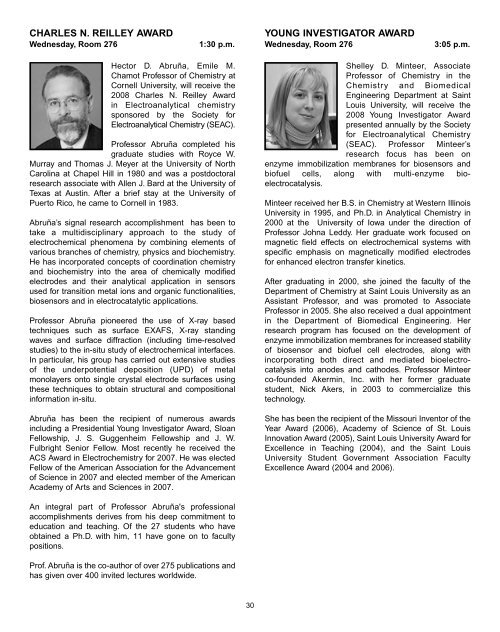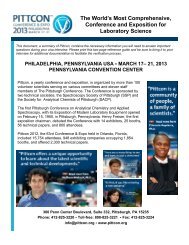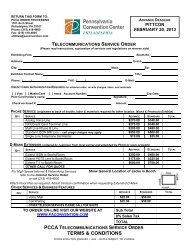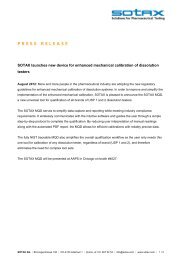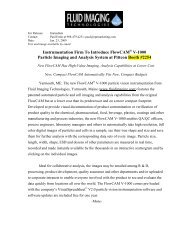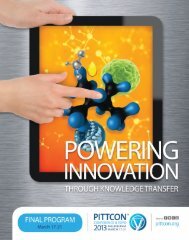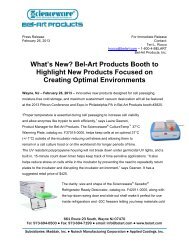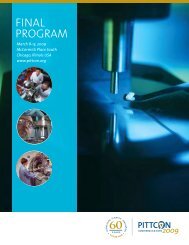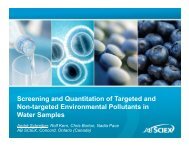2008 Pittcon Final Program - Pittcon Web Archives
2008 Pittcon Final Program - Pittcon Web Archives
2008 Pittcon Final Program - Pittcon Web Archives
Create successful ePaper yourself
Turn your PDF publications into a flip-book with our unique Google optimized e-Paper software.
CHARLES N. REILLEY AWARD<br />
Wednesday, Room 276<br />
1:30 p.m.<br />
YOUNG INVESTIGATOR AWARD<br />
Wednesday, Room 276<br />
3:05 p.m.<br />
Hector D. Abruña, Emile M.<br />
Chamot Professor of Chemistry at<br />
Cornell University, will receive the<br />
<strong>2008</strong> Charles N. Reilley Award<br />
in Electroanalytical chemistry<br />
sponsored by the Society for<br />
Electroanalytical Chemistry (SEAC).<br />
Professor Abruña completed his<br />
graduate studies with Royce W.<br />
Murray and Thomas J. Meyer at the University of North<br />
Carolina at Chapel Hill in 1980 and was a postdoctoral<br />
research associate with Allen J. Bard at the University of<br />
Texas at Austin. After a brief stay at the University of<br />
Puerto Rico, he came to Cornell in 1983.<br />
Abruña’s signal research accomplishment has been to<br />
take a multidisciplinary approach to the study of<br />
electrochemical phenomena by combining elements of<br />
various branches of chemistry, physics and biochemistry.<br />
He has incorporated concepts of coordination chemistry<br />
and biochemistry into the area of chemically modified<br />
electrodes and their analytical application in sensors<br />
used for transition metal ions and organic functionalities,<br />
biosensors and in electrocatalytic applications.<br />
Professor Abruña pioneered the use of X-ray based<br />
techniques such as surface EXAFS, X-ray standing<br />
waves and surface diffraction (including time-resolved<br />
studies) to the in-situ study of electrochemical interfaces.<br />
In particular, his group has carried out extensive studies<br />
of the underpotential deposition (UPD) of metal<br />
monolayers onto single crystal electrode surfaces using<br />
these techniques to obtain structural and compositional<br />
information in-situ.<br />
Abruña has been the recipient of numerous awards<br />
including a Presidential Young Investigator Award, Sloan<br />
Fellowship, J. S. Guggenheim Fellowship and J. W.<br />
Fulbright Senior Fellow. Most recently he received the<br />
ACS Award in Electrochemistry for 2007. He was elected<br />
Fellow of the American Association for the Advancement<br />
of Science in 2007 and elected member of the American<br />
Academy of Arts and Sciences in 2007.<br />
Shelley D. Minteer, Associate<br />
Professor of Chemistry in the<br />
Chemistry and Biomedical<br />
Engineering Department at Saint<br />
Louis University, will receive the<br />
<strong>2008</strong> Young Investigator Award<br />
presented annually by the Society<br />
for Electroanalytical Chemistry<br />
(SEAC). Professor Minteer’s<br />
research focus has been on<br />
enzyme immobilization membranes for biosensors and<br />
biofuel cells, along with multi-enzyme bioelectrocatalysis.<br />
Minteer received her B.S. in Chemistry at Western Illinois<br />
University in 1995, and Ph.D. in Analytical Chemistry in<br />
2000 at the University of Iowa under the direction of<br />
Professor Johna Leddy. Her graduate work focused on<br />
magnetic field effects on electrochemical systems with<br />
specific emphasis on magnetically modified electrodes<br />
for enhanced electron transfer kinetics.<br />
After graduating in 2000, she joined the faculty of the<br />
Department of Chemistry at Saint Louis University as an<br />
Assistant Professor, and was promoted to Associate<br />
Professor in 2005. She also received a dual appointment<br />
in the Department of Biomedical Engineering. Her<br />
research program has focused on the development of<br />
enzyme immobilization membranes for increased stability<br />
of biosensor and biofuel cell electrodes, along with<br />
incorporating both direct and mediated bioelectrocatalysis<br />
into anodes and cathodes. Professor Minteer<br />
co-founded Akermin, Inc. with her former graduate<br />
student, Nick Akers, in 2003 to commercialize this<br />
technology.<br />
She has been the recipient of the Missouri Inventor of the<br />
Year Award (2006), Academy of Science of St. Louis<br />
Innovation Award (2005), Saint Louis University Award for<br />
Excellence in Teaching (2004), and the Saint Louis<br />
University Student Government Association Faculty<br />
Excellence Award (2004 and 2006).<br />
An integral part of Professor Abruña's professional<br />
accomplishments derives from his deep commitment to<br />
education and teaching. Of the 27 students who have<br />
obtained a Ph.D. with him, 11 have gone on to faculty<br />
positions.<br />
Prof. Abruña is the co-author of over 275 publications and<br />
has given over 400 invited lectures worldwide.<br />
30


